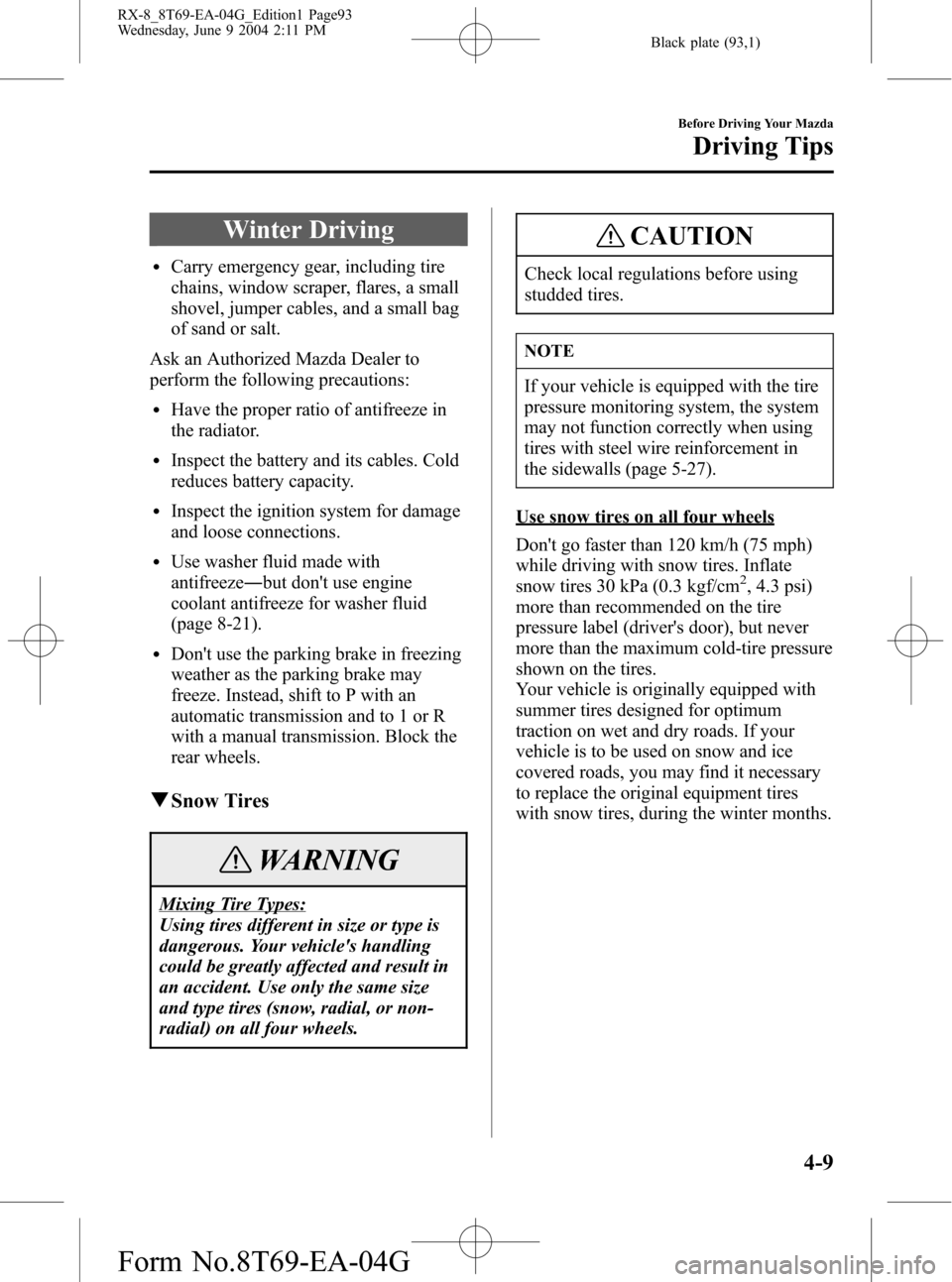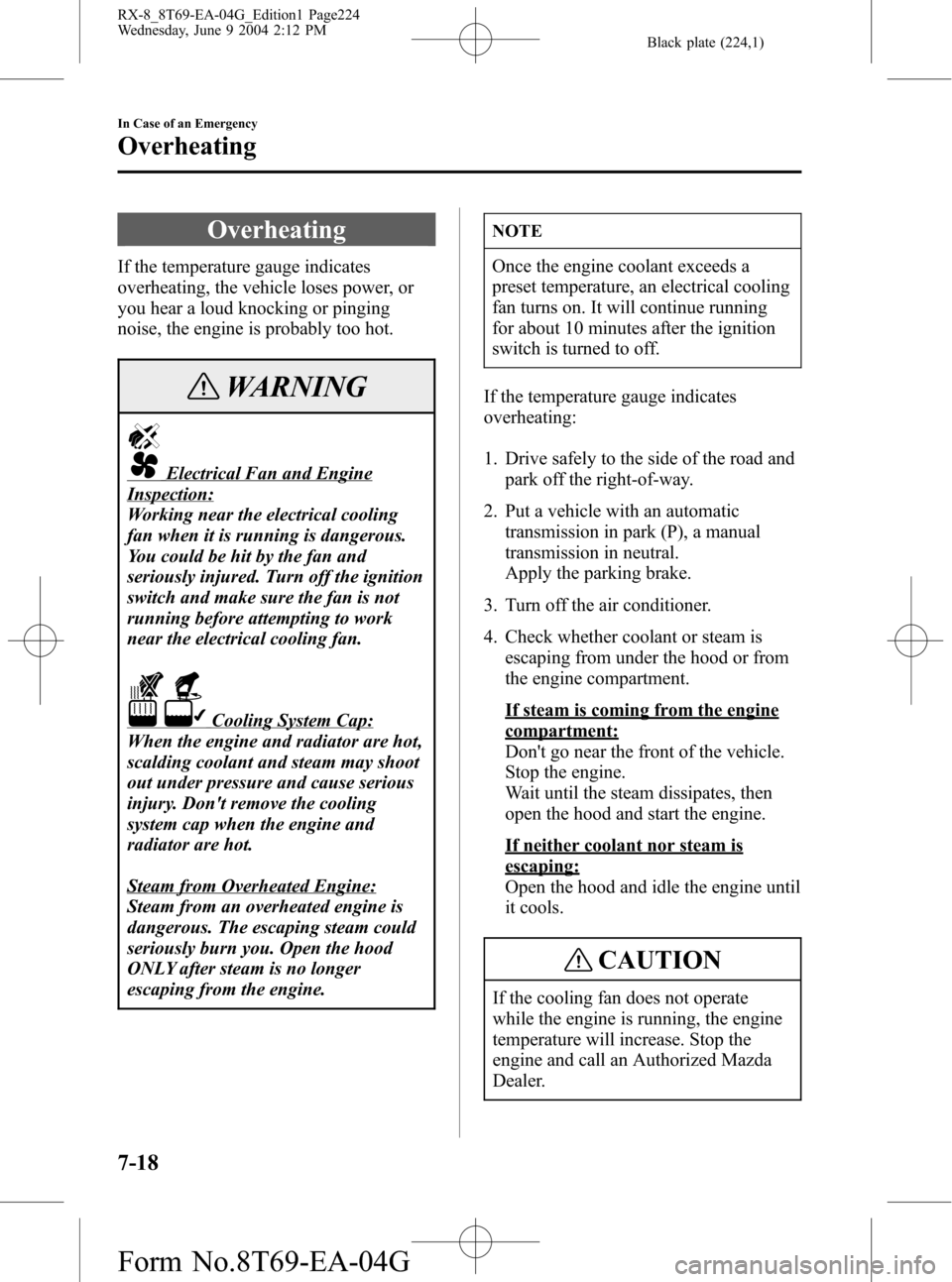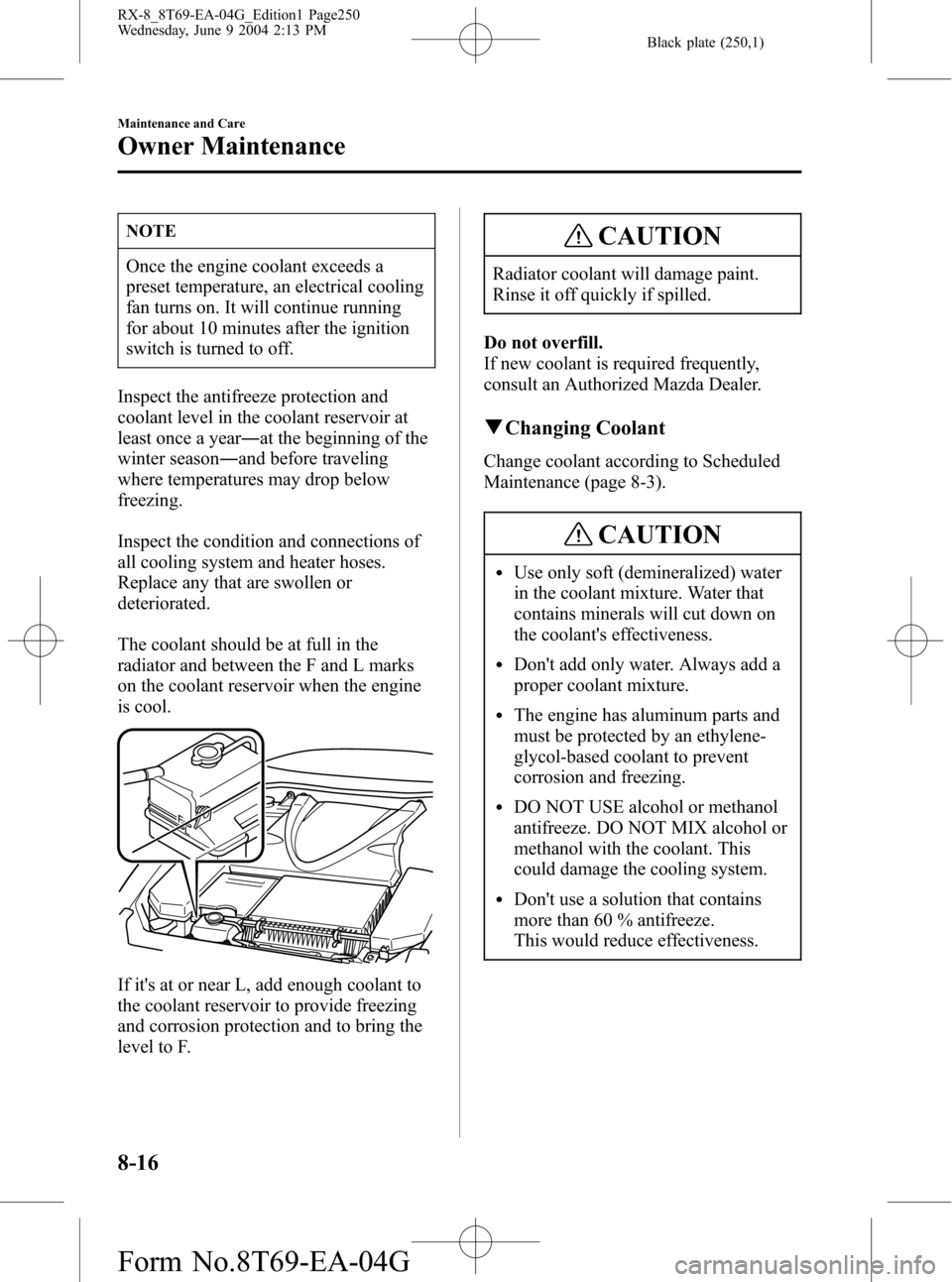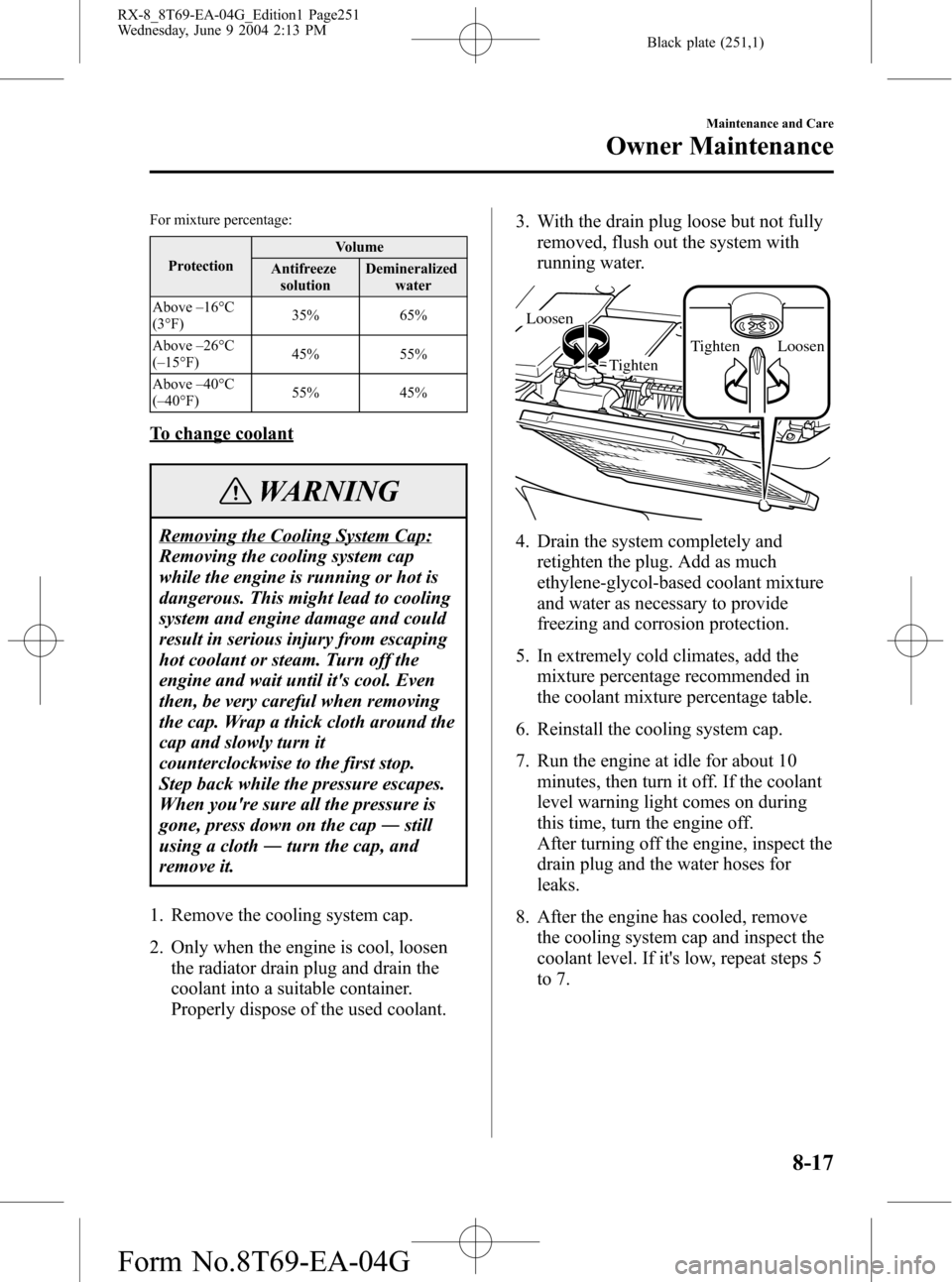radiator MAZDA MODEL RX 8 2005 Owners Manual (in English)
[x] Cancel search | Manufacturer: MAZDA, Model Year: 2005, Model line: MODEL RX 8, Model: MAZDA MODEL RX 8 2005Pages: 364
Page 93 of 364

Black plate (93,1)
Winter Driving
lCarry emergency gear, including tire
chains, window scraper, flares, a small
shovel, jumper cables, and a small bag
of sand or salt.
Ask an Authorized Mazda Dealer to
perform the following precautions:
lHave the proper ratio of antifreeze in
the radiator.
lInspect the battery and its cables. Cold
reduces battery capacity.
lInspect the ignition system for damage
and loose connections.
lUse washer fluid made with
antifreeze―but don't use engine
coolant antifreeze for washer fluid
(page 8-21).
lDon't use the parking brake in freezing
weather as the parking brake may
freeze. Instead, shift to P with an
automatic transmission and to 1 or R
with a manual transmission. Block the
rear wheels.
qSnow Tires
WARNING
Mixing Tire Types:
Using tires different in size or type is
dangerous. Your vehicle's handling
could be greatly affected and result in
an accident. Use only the same size
and type tires (snow, radial, or non-
radial) on all four wheels.
CAUTION
Check local regulations before using
studded tires.
NOTE
If your vehicle is equipped with the tire
pressure monitoring system, the system
may not function correctly when using
tires with steel wire reinforcement in
the sidewalls (page 5-27).
Use snow tires on all four wheels
Don't go faster than 120 km/h (75 mph)
while driving with snow tires. Inflate
snow tires 30 kPa (0.3 kgf/cm
2, 4.3 psi)
more than recommended on the tire
pressure label (driver's door), but never
more than the maximum cold-tire pressure
shown on the tires.
Your vehicle is originally equipped with
summer tires designed for optimum
traction on wet and dry roads. If your
vehicle is to be used on snow and ice
covered roads, you may find it necessary
to replace the original equipment tires
with snow tires, during the winter months.
Before Driving Your Mazda
Driving Tips
4-9
RX-8_8T69-EA-04G_Edition1 Page93
Wednesday, June 9 2004 2:11 PM
Form No.8T69-EA-04G
Page 224 of 364

Black plate (224,1)
Overheating
If the temperature gauge indicates
overheating, the vehicle loses power, or
you hear a loud knocking or pinging
noise, the engine is probably too hot.
WARNING
Electrical Fan and Engine
Inspection:
Working near the electrical cooling
fan when it is running is dangerous.
You could be hit by the fan and
seriously injured. Turn off the ignition
switch and make sure the fan is not
running before attempting to work
near the electrical cooling fan.
Cooling System Cap:
When the engine and radiator are hot,
scalding coolant and steam may shoot
out under pressure and cause serious
injury. Don't remove the cooling
system cap when the engine and
radiator are hot.
Steam from Overheated Engine:
Steam from an overheated engine is
dangerous. The escaping steam could
seriously burn you. Open the hood
ONLY after steam is no longer
escaping from the engine.
NOTE
Once the engine coolant exceeds a
preset temperature, an electrical cooling
fan turns on. It will continue running
for about 10 minutes after the ignition
switch is turned to off.
If the temperature gauge indicates
overheating:
1. Drive safely to the side of the road and
park off the right-of-way.
2. Put a vehicle with an automatic
transmission in park (P), a manual
transmission in neutral.
Apply the parking brake.
3. Turn off the air conditioner.
4. Check whether coolant or steam is
escaping from under the hood or from
the engine compartment.
If steam is coming from the engine
compartment:
Don't go near the front of the vehicle.
Stop the engine.
Wait until the steam dissipates, then
open the hood and start the engine.
If neither coolant nor steam is
escaping:
Open the hood and idle the engine until
it cools.
CAUTION
If the cooling fan does not operate
while the engine is running, the engine
temperature will increase. Stop the
engine and call an Authorized Mazda
Dealer.
7-18
In Case of an Emergency
Overheating
RX-8_8T69-EA-04G_Edition1 Page224
Wednesday, June 9 2004 2:12 PM
Form No.8T69-EA-04G
Page 225 of 364

Black plate (225,1)
5. Make sure the cooling fan is operating,
then turn off the engine after the
temperature has decreased.
6. When cool, check the coolant level.
If it's low, look for coolant leaks from
the radiator and hoses.
If you find a leak or other damage, or if
coolant is still leaking:
Stop the engine and call an Authorized
Mazda Dealer.
If you find no problems, the engine is
cool, and no leaks are obvious:
Carefully add coolant as required (page
8-15).
CAUTION
If the engine continues to overheat or
frequently overheats, have the cooling
system inspected. The engine could be
seriously damaged unless repairs are
made. Consult an Authorized Mazda
Dealer.
In Case of an Emergency
Overheating
7-19
RX-8_8T69-EA-04G_Edition1 Page225
Wednesday, June 9 2004 2:12 PM
Form No.8T69-EA-04G
Page 249 of 364

Black plate (249,1)
Check the oil level and fill to the F mark
if necessary.
Oil capacity (General reference only,
refer to Specifications section for
capacities.)
NOTE
lThe indicated engine oil capacities
are for general reference purposes
only. When adding or changing oil,
verify the engine oil level with the
oil dipstick.
lUse only specified engine oil (page
10-4).
lVerify that the engine cover is
securely installed.
Changing oil filter
Because you need a special tool to
retighten the filter, an Authorized Mazda
Dealer should do the work.
Engine Coolant
qInspecting Coolant Level
WARNING
Hot Engine:
A hot engine is dangerous. If the
engine has been running, parts of the
engine compartment can become very
hot. You could be burned. Carefully
inspect the engine coolant in the
coolant reservoir, but do not open it.
Do not use a match or live flame in the
engine compartment. DO NOT ADD
COOLANT WHEN THE ENGINE IS
HOT.
Electrical Fan and Engine
Inspection:
Working near the electrical cooling
fan when it is running is dangerous.
You could be hit by the fan and
seriously injured. Turn off the ignition
switch and make sure the fan is not
running before attempting to work
near the electrical cooling fan.
Cooling System Cap:
When the engine and radiator are hot,
scalding coolant and steam may shoot
out under pressure and cause serious
injury. Don't remove the cooling
system cap when the engine and
radiator are hot.
Maintenance and Care
Owner Maintenance
8-15
RX-8_8T69-EA-04G_Edition1 Page249
Wednesday, June 9 2004 2:13 PM
Form No.8T69-EA-04G
Page 250 of 364

Black plate (250,1)
NOTE
Once the engine coolant exceeds a
preset temperature, an electrical cooling
fan turns on. It will continue running
for about 10 minutes after the ignition
switch is turned to off.
Inspect the antifreeze protection and
coolant level in the coolant reservoir at
least once a year―at the beginning of the
winter season―and before traveling
where temperatures may drop below
freezing.
Inspect the condition and connections of
all cooling system and heater hoses.
Replace any that are swollen or
deteriorated.
The coolant should be at full in the
radiator and between the F and L marks
on the coolant reservoir when the engine
is cool.
If it's at or near L, add enough coolant to
the coolant reservoir to provide freezing
and corrosion protection and to bring the
level to F.
CAUTION
Radiator coolant will damage paint.
Rinse it off quickly if spilled.
Do not overfill.
If new coolant is required frequently,
consult an Authorized Mazda Dealer.
qChanging Coolant
Change coolant according to Scheduled
Maintenance (page 8-3).
CAUTION
lUse only soft (demineralized) water
in the coolant mixture. Water that
contains minerals will cut down on
the coolant's effectiveness.
lDon't add only water. Always add a
proper coolant mixture.
lThe engine has aluminum parts and
must be protected by an ethylene-
glycol-based coolant to prevent
corrosion and freezing.
lDO NOT USE alcohol or methanol
antifreeze. DO NOT MIX alcohol or
methanol with the coolant. This
could damage the cooling system.
lDon't use a solution that contains
more than 60 % antifreeze.
This would reduce effectiveness.
8-16
Maintenance and Care
Owner Maintenance
RX-8_8T69-EA-04G_Edition1 Page250
Wednesday, June 9 2004 2:13 PM
Form No.8T69-EA-04G
Page 251 of 364

Black plate (251,1)
For mixture percentage:
ProtectionVolume
Antifreeze
solutionDemineralized
water
Above–16°C
(3°F)35% 65%
Above–26°C
(–15°F)45% 55%
Above–40°C
(–40°F)55% 45%
To change coolant
WARNING
Removing the Cooling System Cap:
Removing the cooling system cap
while the engine is running or hot is
dangerous. This might lead to cooling
system and engine damage and could
result in serious injury from escaping
hot coolant or steam. Turn off the
engine and wait until it's cool. Even
then, be very careful when removing
the cap. Wrap a thick cloth around the
cap and slowly turn it
counterclockwise to the first stop.
Step back while the pressure escapes.
When you're sure all the pressure is
gone, press down on the cap―still
using a cloth―turn the cap, and
remove it.
1. Remove the cooling system cap.
2. Only when the engine is cool, loosen
the radiator drain plug and drain the
coolant into a suitable container.
Properly dispose of the used coolant.3. With the drain plug loose but not fully
removed, flush out the system with
running water.
Tighten Loosen Loosen
Tighten
4. Drain the system completely and
retighten the plug. Add as much
ethylene-glycol-based coolant mixture
and water as necessary to provide
freezing and corrosion protection.
5. In extremely cold climates, add the
mixture percentage recommended in
the coolant mixture percentage table.
6. Reinstall the cooling system cap.
7. Run the engine at idle for about 10
minutes, then turn it off. If the coolant
level warning light comes on during
this time, turn the engine off.
After turning off the engine, inspect the
drain plug and the water hoses for
leaks.
8. After the engine has cooled, remove
the cooling system cap and inspect the
coolant level. If it's low, repeat steps 5
to 7.
Maintenance and Care
Owner Maintenance
8-17
RX-8_8T69-EA-04G_Edition1 Page251
Wednesday, June 9 2004 2:13 PM
Form No.8T69-EA-04G
Page 255 of 364

Black plate (255,1)
Washer Fluid
qInspecting Washer Fluid Level
WARNING
Substitute Washer Fluid:
Using radiator antifreeze as washer
fluid is dangerous. If sprayed on the
windshield, it will dirty the windshield,
affect your visibility, and could result
in an accident. Use only windshield
washer fluid or plain water in the
reservoir.
Using Washer Fluid Without Anti-
freeze Protection in Cold Weather:
Operating your vehicle in
temperatures below 4 degrees C (40
degrees F) using washer fluid without
anti-freeze protection is dangerous as
it could cause impaired windshield
vision and result in an accident. In
cold weather, always use washer fluid
with anti-freeze protection.
NOTE
State or local regulations may restrict
the use of volatile organic compounds
(VOCs), which are commonly used as
anti-freeze agents in washer fluid. A
washer fluid with limited VOC content
should be used only if it provides
adequate freeze resistance for all
regions and climates in which the
vehicle will be operated.Inspect fluid level in the washer fluid
reservoir; add fluid if necessary.
Full
LowOK
Use plain water if washer fluid is
unavailable.
But use only washer fluid in cold weather
to prevent it from freezing.
Maintenance and Care
Owner Maintenance
8-21
RX-8_8T69-EA-04G_Edition1 Page255
Wednesday, June 9 2004 2:13 PM
Form No.8T69-EA-04G